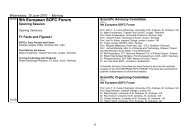European Fuel Cell Forum 2011
European Fuel Cell Forum 2011
European Fuel Cell Forum 2011
Create successful ePaper yourself
Turn your PDF publications into a flip-book with our unique Google optimized e-Paper software.
�<br />
�<br />
<strong>European</strong> <strong>Fuel</strong> <strong>Cell</strong> <strong>Forum</strong> <strong>2011</strong> 28 June -1 July <strong>2011</strong>, Lucerne Switzerland<br />
A0404<br />
PEMFCs compared to other technologies for air<br />
independent energy supply<br />
Thomas Nietsch, Olivier Verdu<br />
HELION-AREVA<br />
Domaine du Petit Arbois<br />
Bâtimet J. Verne, BP 71<br />
FR-13545 Aix-en-Provence Cedex 4 / France<br />
Tel.: +33-4-4290-3898<br />
Fax: +33-4-4290-8197<br />
olivier.verdu@areva.com<br />
Abstract<br />
This work compares PEMFCs with other technologies suitable for air independent energy<br />
storage, potentially usable in manned or unmanned underwater vehicles, satellites and<br />
other space application.<br />
In a first round a list of over 30 technologies was drawn up and down selected to a smaller<br />
number for a more detailed investigation. Most important down selection criteria are the<br />
technology readiness level and operating conditions compatible with the envisaged<br />
applications. The down selected technologies were compared in terms of performance,<br />
costs and technology readiness as off today and a forecast for the near future is given of<br />
wide range of applications or mission profiles.<br />
The considered performance characteristic includes energy per weight (specific energy,<br />
kWh/kg), energy per volume (energy density, kWh/l), number of charge / discharge cycles<br />
and life time. The gathered economical characteristics are the specific installation costs<br />
(€/kW or €/kWh), operating and maintenance costs. These costs might include direct costs<br />
for the vehicle as well as indirect costs for infrastructure, etc.<br />
The performance data in this work are not performances related to specific suppliers but to<br />
the technology itself and as such generic data. Supplementary volume, weight and costs<br />
for the balance of plant, infrastructure and maintenance are added to find the complete<br />
systems performance. This was done by using our own experience, results and the<br />
companies general experience and database.<br />
By doing this we were able to identify the most suitable technologies of the envisaged<br />
application based on today’s performance and for most likely expected future<br />
performances. These are Li based batteries for high power at lower energy; metal sea<br />
water batteries for very low power over very long time (high energy) and PEMFC based<br />
systems for reasonable power at high energy.<br />
Parts of the work were carried out under the <strong>European</strong> Defence Agency (EDA) project<br />
“Energy supply for Unmanned Underwater Vehicles (ESUUV) Reference Nº 09-R&T-006.<br />
The other consortium members were ECA and Nexter.<br />
PEMFC Applications A04 - 4/8<br />
�<br />
�<br />
<strong>European</strong> <strong>Fuel</strong> <strong>Cell</strong> <strong>Forum</strong> <strong>2011</strong> 28 June -1 July <strong>2011</strong>, Lucerne Switzerland<br />
A0405<br />
Uninterruptible Power Supply with<br />
PEM <strong>Fuel</strong> <strong>Cell</strong> Technology<br />
Ulrike Trachte, Mirko Kleingries, Beat Wellig<br />
Lucerne School of Engineering and Architecture<br />
CC Thermal Energy Systems & Process Engineering<br />
Technikumstrasse 21, CH-6048 Horw<br />
Tel.: +41-41-3493-249<br />
Fax: +41-41-3493-960<br />
ulrike.trachte@hslu.ch<br />
Abstract<br />
Important technical functions such as telecommunication services are protected against<br />
grid failures by uninterruptible power supply (UPS) systems. In most cases the emergency<br />
power is provided by lead acid batteries. Lead-acid batteries are sensitive with regard to<br />
variations in temperature, difficult to control and contain harmful materials.<br />
A more environment-friendly alternative are fuel cells (FC). In this project the lead acid<br />
batteries of an UPS system were replaced by a commercial PEM FC System and � to<br />
avoid any batteries � the delayed start-up behaviour of the FC was bridged with super<br />
capacitor technology.<br />
The aim of the project was to prove the functional, efficient and reliable operation of the FC<br />
system under real conditions and over a long-term period. For this reason the system was<br />
connected to a real operating base station of a telecommunication service provider near<br />
Lucerne from January 2006 until end of 2009. The field test included monthly grid failure<br />
simulations of 5x5 minutes and 2x20 minutes as well as several 4 hour simulations.<br />
Hydrogen was supplied by two 50 l pressure cylinders which were able to provide a standalone<br />
operation of the installation for about 6 hours.<br />
Approximately 350 start-ups including two real outages confirmed the functionality and<br />
reliability of the system. Under the load of the base station the FC system started with a<br />
reliability of 100%. At the end of the tests a decrease of the FC voltage of about 3.3% was<br />
observed. An amount of electrical energy of about 470 kWh was provided. The FC system<br />
was still fully operational at this time.<br />
The project was realised with two industrial partners and the financial support of the Swiss<br />
federal office of energy (SFOE). During the project period of more than three years an<br />
increasing number of FC producers and UPS suppliers became aware that the application<br />
of FCs as a back-up system responds to critical market demands and developed ready-tomarket<br />
products. Hence, for the FC UPS application, it is no longer the question of<br />
functionality but of a successful market entry.<br />
This early market is now supported by the FC and Hydrogen Joint Undertaking (FCH JU)<br />
Program. The Lucerne School of Engineering and Architecture takes part in the<br />
EU-project ‘<strong>Fuel</strong> cell field test demonstration of economic and environmental<br />
viability for portable generators, backup and UPS power system applications’ (FITUP) to<br />
demonstrate the application readiness for these back-up systems and to contribute to a<br />
widespread acceptance of this new technology.<br />
PEMFC Applications A04 - 5/8




